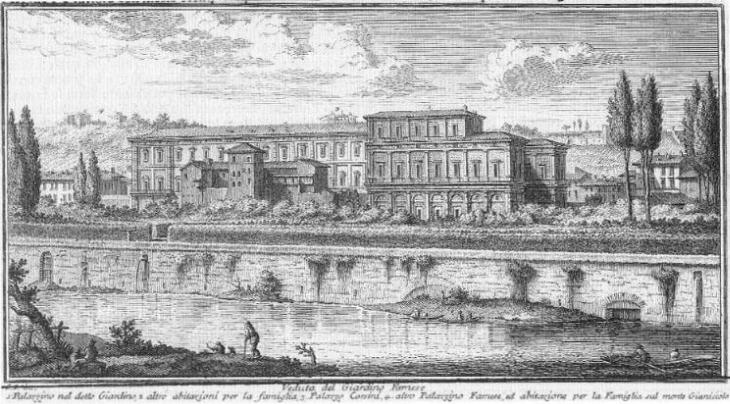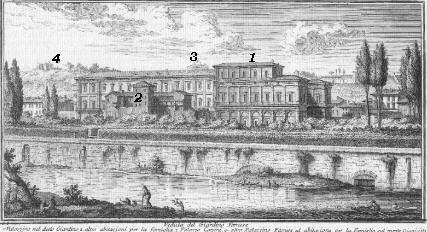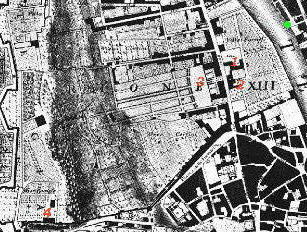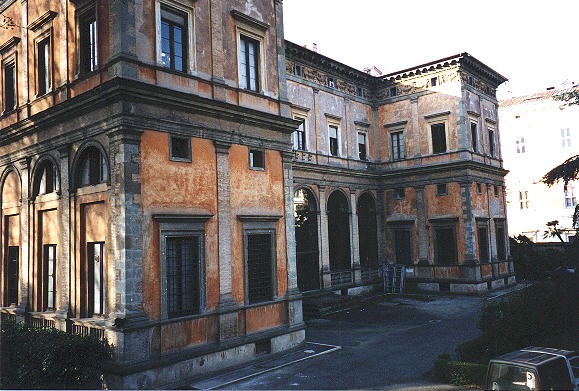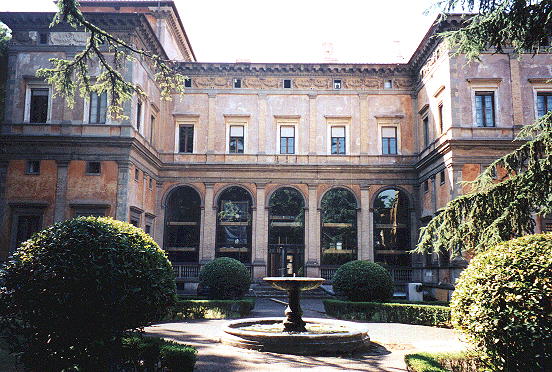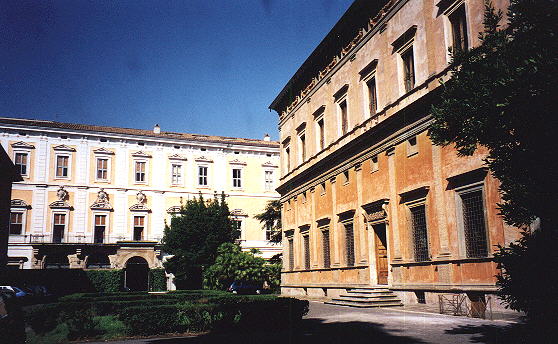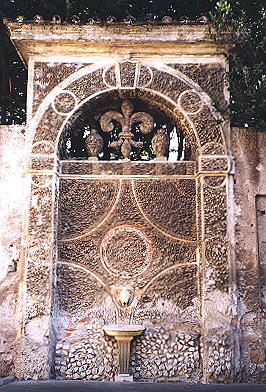

Veduta del Giardino Farnese
(Book
5) (Map
D3) (Day 6) (View D7)
(Rione Trastevere)
In this page:
The plate by Giuseppe Vasi
Today's view
La Farnesina
The Plate (No. 88)
The river flows into a very narrow passage. Vasi's viewpoint is the
back of Palazzo Farnese and from there he shows
the other possessions of the Farnese in Rome. Immediately on the other
side of the river there is La Farnesina and behind it on Mount Janiculus
another villa (Casino) of the Farnese. The view is taken from the green dot in the small 1748 map here below.
In the description below the plate Vasi made reference to: 1) Palazzino Farnese (La Farnesina);
2) Other buildings in the garden; 3) Palazzo Corsini; 4) Casino Farnese al Gianicolo.
3) and 4) are shown in detail in other pages.
Today
The redesigning of the river flow inside Rome required the sacrifice
of most of the garden and the view is necessarily much closer to the building.
Read William Dean Howells' account of his visit to this site in 1908.
La
Farnesina
The Villa was erected in 1506 for Agostino Chigi a very rich banker
of Siena by Baldassarre Peruzzi. The ceilings are painted by Raphael, Giulio
Romano, Peruzzi himself, Sodoma and their pupils. Agostino Chigi made such
a fortune as a papal banker that he could throw in the river the golden
dishes used for his dinners (although he is suspected of having put nets
in the water to recover them). In 1580 the Villa was bought by the Farnese
and acquired the current name, being smaller (ina is the suffix which means
small), than Palazzo Farnese. Close to La Farnesina is Palazzo
Corsini.
Below an example of the decoration of the gardens.
Excerpts from Giuseppe Vasi 1761 Itinerary related to this page:
Palazzino e giardino Farnese
Sulle sponde del Tevere, ove si crede essere stati gli orti di Geta, si vede il delizioso giardino col magnifico
casino eretto dal famoso banchiere Agostino Ghigi per dare un lauto pranzo a Leone X. con molti
Cardinali. Contiene questo nel pianterreno tre gallerie con alcune camere di riposo; nella prima dipinse
Raffaella da Urbino il convito degli Dei, con altre favole ajutato da Giulio Romano, Gaudenzio Milanese, e
Raffaellino del Colla; i fiori per˛ e frutta intorno alla volta con alcuni animali sono opere di Gio. da Udine.
Baldassare Peruzzi, che fu l'architetto della fabbrica, dipinse nella volta della seconda galleria il carro di
Diana, e l'istoria di Medusa, con alcuni stucchi finti, ma tanto simili al vero, che Tiziano a prima vista
credette che fossero di rilievo, come realmente sembrano a tutti. Si osserva in una lunetta una gran testa
fatta di chiaro e scuro, quale si dice essere stata fatta dal Buonarroti per riprendere la maniera minuta di
quelle pitture. Sotto il cornicione poi si vede la celebre Galatea dipinta di mano di Raffaelle da Urbino. In
queste due gallerie sono in oggi buona parte delle statue e busti che stavano nelle stanze del palazzo
Farnese; e ultimamente vi Ŕ stata ancora portata la celebre statua di Agrippina, madre di Nerone, che
stava negli orti Farnesiani di campo vaccino, come giÓ dicemmo. Nell'appartamento superiore evvi una
stanza dipinta da Giulio Romano, ripulita ultimamente coll' assistenza di Carlo Maratta, ed altre pitture
sonovi di figure, e di architettura; ma perchŔ hanno patito, non meritano considerazione: onde
passeremo a vedere il vicino
Palazzo di Agostino Ghigi
Medesimamente col disegno di Baldassare Peruzzi fu eretto il palazzo, che siegue al piccolo Farnese:
ma perchŔ lasciato in abbandono, resta ora in stato quasi da rovinare, e serve ad uso di fenile.
|
Next plate in Book 5: Ponte Sisto
Next step in Day 6 itinerary: Porta S. Spirito

Go
to  or to Book
5 or to my
Home
Page on Baroque Rome or to my Home Page on Rome
in the footsteps of an XVIIIth century traveller.
or to Book
5 or to my
Home
Page on Baroque Rome or to my Home Page on Rome
in the footsteps of an XVIIIth century traveller.
|


